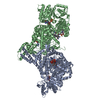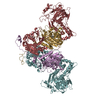[English] 日本語
 Yorodumi
Yorodumi- PDB-6pwc: A complex structure of arrestin-2 bound to neurotensin receptor 1 -
+ Open data
Open data
- Basic information
Basic information
| Entry | Database: PDB / ID: 6pwc | ||||||||||||||||||||||||||||||||||||||||||
|---|---|---|---|---|---|---|---|---|---|---|---|---|---|---|---|---|---|---|---|---|---|---|---|---|---|---|---|---|---|---|---|---|---|---|---|---|---|---|---|---|---|---|---|
| Title | A complex structure of arrestin-2 bound to neurotensin receptor 1 | ||||||||||||||||||||||||||||||||||||||||||
 Components Components |
| ||||||||||||||||||||||||||||||||||||||||||
 Keywords Keywords | SIGNALING PROTEIN / cryo-EM structure / beta-arrestin / neurotensin receptor / beta-arrestin-GPCR complex | ||||||||||||||||||||||||||||||||||||||||||
| Function / homology |  Function and homology information Function and homology informationG protein-coupled neurotensin receptor activity / inositol phosphate catabolic process / symmetric synapse / angiotensin receptor binding / D-aspartate import across plasma membrane / positive regulation of gamma-aminobutyric acid secretion / TGFBR3 regulates TGF-beta signaling / Activation of SMO / regulation of membrane depolarization / positive regulation of arachidonate secretion ...G protein-coupled neurotensin receptor activity / inositol phosphate catabolic process / symmetric synapse / angiotensin receptor binding / D-aspartate import across plasma membrane / positive regulation of gamma-aminobutyric acid secretion / TGFBR3 regulates TGF-beta signaling / Activation of SMO / regulation of membrane depolarization / positive regulation of arachidonate secretion / negative regulation of interleukin-8 production / L-glutamate import across plasma membrane / regulation of respiratory gaseous exchange / positive regulation of inhibitory postsynaptic potential / arrestin family protein binding / negative regulation of systemic arterial blood pressure / G protein-coupled receptor internalization / negative regulation of release of sequestered calcium ion into cytosol / positive regulation of glutamate secretion / Lysosome Vesicle Biogenesis / temperature homeostasis / : / response to lipid / positive regulation of cardiac muscle hypertrophy / stress fiber assembly / Golgi Associated Vesicle Biogenesis / positive regulation of inositol phosphate biosynthetic process / positive regulation of Rho protein signal transduction / detection of temperature stimulus involved in sensory perception of pain / pseudopodium / negative regulation of interleukin-6 production / positive regulation of receptor internalization / negative regulation of Notch signaling pathway / enzyme inhibitor activity / neuropeptide signaling pathway / insulin-like growth factor receptor binding / clathrin-coated pit / negative regulation of protein ubiquitination / GTPase activator activity / cytoplasmic vesicle membrane / Activated NOTCH1 Transmits Signal to the Nucleus / Peptide ligand-binding receptors / positive regulation of release of sequestered calcium ion into cytosol / dendritic shaft / adult locomotory behavior / learning / Signaling by high-kinase activity BRAF mutants / G protein-coupled receptor binding / MAP2K and MAPK activation / G protein-coupled receptor activity / cytoplasmic side of plasma membrane / positive regulation of protein phosphorylation / terminal bouton / Signaling by RAF1 mutants / Signaling by moderate kinase activity BRAF mutants / Paradoxical activation of RAF signaling by kinase inactive BRAF / Signaling downstream of RAS mutants / endocytic vesicle membrane / Signaling by BRAF and RAF1 fusions / Cargo recognition for clathrin-mediated endocytosis / protein transport / Clathrin-mediated endocytosis / Thrombin signalling through proteinase activated receptors (PARs) / cytoplasmic vesicle / ubiquitin-dependent protein catabolic process / perikaryon / G alpha (s) signalling events / G alpha (q) signalling events / dendritic spine / chemical synaptic transmission / molecular adaptor activity / proteasome-mediated ubiquitin-dependent protein catabolic process / transcription coactivator activity / positive regulation of ERK1 and ERK2 cascade / Ub-specific processing proteases / nuclear body / protein ubiquitination / positive regulation of apoptotic process / membrane raft / G protein-coupled receptor signaling pathway / Golgi membrane / lysosomal membrane / ubiquitin protein ligase binding / positive regulation of gene expression / regulation of transcription by RNA polymerase II / negative regulation of apoptotic process / chromatin / protein-containing complex binding / cell surface / endoplasmic reticulum / Golgi apparatus / signal transduction / positive regulation of transcription by RNA polymerase II / nucleoplasm / identical protein binding / nucleus / plasma membrane / cytosol / cytoplasm Similarity search - Function | ||||||||||||||||||||||||||||||||||||||||||
| Biological species |  Homo sapiens (human) Homo sapiens (human)synthetic construct (others) | ||||||||||||||||||||||||||||||||||||||||||
| Method | ELECTRON MICROSCOPY / single particle reconstruction / cryo EM / Resolution: 4.9 Å | ||||||||||||||||||||||||||||||||||||||||||
 Authors Authors | Yin, W. / Li, Z. / Jin, M. / Yin, Y.-L. / de Waal, P.W. / Pal, K. / Gao, X. / He, Y. / Gao, J. / Wang, X. ...Yin, W. / Li, Z. / Jin, M. / Yin, Y.-L. / de Waal, P.W. / Pal, K. / Gao, X. / He, Y. / Gao, J. / Wang, X. / Zhang, Y. / Zhou, H. / Melcher, K. / Jiang, Y. / Cong, Y. / Zhou, X.E. / Yu, X. / Xu, H.E. | ||||||||||||||||||||||||||||||||||||||||||
| Funding support |  United States, United States,  China, 2items China, 2items
| ||||||||||||||||||||||||||||||||||||||||||
 Citation Citation |  Journal: Cell Res / Year: 2019 Journal: Cell Res / Year: 2019Title: A complex structure of arrestin-2 bound to a G protein-coupled receptor. Authors: Wanchao Yin / Zhihai Li / Mingliang Jin / Yu-Ling Yin / Parker W de Waal / Kuntal Pal / Yanting Yin / Xiang Gao / Yuanzheng He / Jing Gao / Xiaoxi Wang / Yan Zhang / Hu Zhou / Karsten ...Authors: Wanchao Yin / Zhihai Li / Mingliang Jin / Yu-Ling Yin / Parker W de Waal / Kuntal Pal / Yanting Yin / Xiang Gao / Yuanzheng He / Jing Gao / Xiaoxi Wang / Yan Zhang / Hu Zhou / Karsten Melcher / Yi Jiang / Yao Cong / X Edward Zhou / Xuekui Yu / H Eric Xu /    Abstract: Arrestins comprise a family of signal regulators of G-protein-coupled receptors (GPCRs), which include arrestins 1 to 4. While arrestins 1 and 4 are visual arrestins dedicated to rhodopsin, arrestins ...Arrestins comprise a family of signal regulators of G-protein-coupled receptors (GPCRs), which include arrestins 1 to 4. While arrestins 1 and 4 are visual arrestins dedicated to rhodopsin, arrestins 2 and 3 (Arr2 and Arr3) are β-arrestins known to regulate many nonvisual GPCRs. The dynamic and promiscuous coupling of Arr2 to nonvisual GPCRs has posed technical challenges to tackle the basis of arrestin binding to GPCRs. Here we report the structure of Arr2 in complex with neurotensin receptor 1 (NTSR1), which reveals an overall assembly that is strikingly different from the visual arrestin-rhodopsin complex by a 90° rotation of Arr2 relative to the receptor. In this new configuration, intracellular loop 3 (ICL3) and transmembrane helix 6 (TM6) of the receptor are oriented toward the N-terminal domain of the arrestin, making it possible for GPCRs that lack the C-terminal tail to couple Arr2 through their ICL3. Molecular dynamics simulation and crosslinking data further support the assembly of the Arr2‒NTSR1 complex. Sequence analysis and homology modeling suggest that the Arr2‒NTSR1 complex structure may provide an alternative template for modeling arrestin-GPCR interactions. | ||||||||||||||||||||||||||||||||||||||||||
| History |
|
- Structure visualization
Structure visualization
| Movie |
 Movie viewer Movie viewer |
|---|---|
| Structure viewer | Molecule:  Molmil Molmil Jmol/JSmol Jmol/JSmol |
- Downloads & links
Downloads & links
- Download
Download
| PDBx/mmCIF format |  6pwc.cif.gz 6pwc.cif.gz | 172 KB | Display |  PDBx/mmCIF format PDBx/mmCIF format |
|---|---|---|---|---|
| PDB format |  pdb6pwc.ent.gz pdb6pwc.ent.gz | 116.8 KB | Display |  PDB format PDB format |
| PDBx/mmJSON format |  6pwc.json.gz 6pwc.json.gz | Tree view |  PDBx/mmJSON format PDBx/mmJSON format | |
| Others |  Other downloads Other downloads |
-Validation report
| Summary document |  6pwc_validation.pdf.gz 6pwc_validation.pdf.gz | 832.3 KB | Display |  wwPDB validaton report wwPDB validaton report |
|---|---|---|---|---|
| Full document |  6pwc_full_validation.pdf.gz 6pwc_full_validation.pdf.gz | 833.6 KB | Display | |
| Data in XML |  6pwc_validation.xml.gz 6pwc_validation.xml.gz | 29.1 KB | Display | |
| Data in CIF |  6pwc_validation.cif.gz 6pwc_validation.cif.gz | 46.1 KB | Display | |
| Arichive directory |  https://data.pdbj.org/pub/pdb/validation_reports/pw/6pwc https://data.pdbj.org/pub/pdb/validation_reports/pw/6pwc ftp://data.pdbj.org/pub/pdb/validation_reports/pw/6pwc ftp://data.pdbj.org/pub/pdb/validation_reports/pw/6pwc | HTTPS FTP |
-Related structure data
| Related structure data |  20505MC M: map data used to model this data C: citing same article ( |
|---|---|
| Similar structure data |
- Links
Links
- Assembly
Assembly
| Deposited unit | 
|
|---|---|
| 1 |
|
- Components
Components
| #1: Protein | Mass: 41555.387 Da / Num. of mol.: 1 Source method: isolated from a genetically manipulated source Source: (gene. exp.)  Homo sapiens (human) / Gene: NTSR1, NTRR / Production host: Homo sapiens (human) / Gene: NTSR1, NTRR / Production host:  |
|---|---|
| #2: Protein/peptide | Mass: 819.007 Da / Num. of mol.: 1 / Source method: obtained synthetically / Source: (synth.) synthetic construct (others) |
| #3: Protein | Mass: 44161.359 Da / Num. of mol.: 1 Source method: isolated from a genetically manipulated source Source: (gene. exp.)  Homo sapiens (human) / Gene: ARRB1, ARR1 / Production host: Homo sapiens (human) / Gene: ARRB1, ARR1 / Production host:  |
| #4: Antibody | Mass: 25689.643 Da / Num. of mol.: 1 Source method: isolated from a genetically manipulated source Source: (gene. exp.) synthetic construct (others) / Production host:  |
| #5: Antibody | Mass: 23435.064 Da / Num. of mol.: 1 Source method: isolated from a genetically manipulated source Source: (gene. exp.) synthetic construct (others) / Production host:  |
| Has ligand of interest | N |
| Has protein modification | Y |
-Experimental details
-Experiment
| Experiment | Method: ELECTRON MICROSCOPY |
|---|---|
| EM experiment | Aggregation state: PARTICLE / 3D reconstruction method: single particle reconstruction |
- Sample preparation
Sample preparation
| Component | Name: Fusion complex of Bril-NTSR1-beta-arrestin1-fab30 / Type: COMPLEX / Entity ID: all / Source: RECOMBINANT |
|---|---|
| Source (natural) | Organism:  Homo sapiens (human) Homo sapiens (human) |
| Source (recombinant) | Organism:  |
| Buffer solution | pH: 7.4 |
| Specimen | Embedding applied: NO / Shadowing applied: NO / Staining applied: NO / Vitrification applied: YES |
| Vitrification | Cryogen name: ETHANE |
- Electron microscopy imaging
Electron microscopy imaging
| Experimental equipment |  Model: Titan Krios / Image courtesy: FEI Company |
|---|---|
| Microscopy | Model: FEI TITAN KRIOS |
| Electron gun | Electron source:  FIELD EMISSION GUN / Accelerating voltage: 300 kV / Illumination mode: FLOOD BEAM FIELD EMISSION GUN / Accelerating voltage: 300 kV / Illumination mode: FLOOD BEAM |
| Electron lens | Mode: BRIGHT FIELD |
| Image recording | Electron dose: 68 e/Å2 / Film or detector model: GATAN K2 BASE (4k x 4k) |
- Processing
Processing
| Software | Name: PHENIX / Version: 1.13_2998: / Classification: refinement | |||||||||
|---|---|---|---|---|---|---|---|---|---|---|
| EM software |
| |||||||||
| CTF correction | Type: NONE | |||||||||
| Symmetry | Point symmetry: C1 (asymmetric) | |||||||||
| 3D reconstruction | Resolution: 4.9 Å / Resolution method: FSC 0.143 CUT-OFF / Num. of particles: 260322 / Symmetry type: POINT |
 Movie
Movie Controller
Controller










 PDBj
PDBj


















